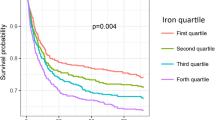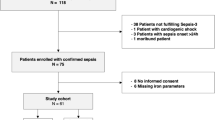Abstract
Purpose
As iron is essential for both immune function and microbial growth, alterations in iron status could influence the risk of infections. We assessed the associations of iron status with risk of bloodstream infections (BSIs) and BSI mortality.
Methods
We measured serum iron, transferrin saturation (Tsat) and total iron-binding capacity (TIBC) in 61,852 participants in the population-based HUNT2 study (1995–97). Incident BSIs (1995–2011) were identified through linkage with the Mid-Norway Sepsis Register, which includes prospectively registered information on BSI from local and regional hospitals. We assessed the risk of a first-time BSI and BSI mortality with the iron indices using Cox proportional hazards regression analysis.
Results
During a median follow-up of 14.8 years, 1738 individuals experienced at least one episode of BSI, and 370 died within 30 days after a BSI. In age- and sex-adjusted analyses, BSI risk was increased among participants with indices of iron deficiency, serum iron ≤ 2.5th percentile (HR 1.72, 95% CI 1.34–2.21), Tsat ≤ 2.5th percentile (HR 1.48, 95% CI 1.12–1.96) or TIBC ≥ 97.5th percentile (HR 1.46, 95% CI 1.06–2.01). The associations remained similar after adjusting for comorbidities and exclusion of BSI related to cancer, rheumatic illnesses and inflammatory bowel disease. BSI mortality showed similar associations.
Conclusion
Indices of severe iron deficiency are associated with an increased risk of a future BSI.

Similar content being viewed by others
References
Cohen J, Vincent JL, Adhikari NK, Machado FR, Angus DC et al (2015) Sepsis: a roadmap for future research. Lancet Infect Dis 15:581–614
Rhodes A, Evans LE, Alhazzani W, Levy MM, Antonelli M et al (2017) Surviving sepsis campaign: international guidelines for management of sepsis and septic shock: 2016. Intensive Care Med 43:304–377
Henriksen DP, Pottegard A, Laursen CB, Jensen TG, Hallas J et al (2015) Risk factors for hospitalization due to community-acquired sepsis—a population-based case-control study. PLoS One 10:e0124838
Paulsen J, Askim A, Mohus RM, Mehl A, Dewan A et al (2017) Associations of obesity and lifestyle with the risk and mortality of bloodstream infection in a general population: a 15-year follow-up of 64 027 individuals in the HUNT Study. Int J Epidemiol 46:1573–1581
Wang HE, Shapiro NI, Griffin R, Safford MM, Judd S et al (2012) Chronic medical conditions and risk of sepsis. PLoS One 7:e48307
Reddick LE, Alto NM (2014) Bacteria fighting back: how pathogens target and subvert the host innate immune system. Mol Cell 54:321–328
Ganz T, Nemeth E (2015) Iron homeostasis in host defence and inflammation. Nat Rev Immunol 15:500–510
Perner A, Gordon AC, De Backer D, Dimopoulos G, Russell JA et al (2016) Sepsis: frontiers in diagnosis, resuscitation and antibiotic therapy. Intensive Care Med 42:1958–1969
Hussain SQ, Ashraf M, Wani JG, Ahmed J (2014) Low hemoglobin level a risk factor for acute lower respiratory tract infections (ALRTI) in children. J Clin Diag Res 8:Pc01–Pc03
Gwamaka M, Kurtis JD, Sorensen BE, Holte S, Morrison R et al (2012) Iron deficiency protects against severe Plasmodium falciparum malaria and death in young children. Clin Infect Dis 54:1137–1144
Drakesmith H, Prentice AM (2012) Hepcidin and the iron-infection axis. Science 338:768–772
Bassetti M, Poulakou G, Ruppe E, Bouza E, Van Hal SJ et al (2017) Antimicrobial resistance in the next 30 years, humankind, bugs and drugs: a visionary approach. Intensive Care Med 43:1464–1475
Askim A, Mehl A, Paulsen J, DeWan AT, Vestrheim DF et al (2016) Epidemiology and outcome of sepsis in adult patients with Streptococcus pneumoniae infection in a Norwegian county 1993–2011: an observational study. BMC Infect Dis 16:223
Paulsen J, Mehl A, Askim A, Solligard E, Asvold BO et al (2015) Epidemiology and outcome of Staphylococcus aureus bloodstream infection and sepsis in a Norwegian county 1996–2011: an observational study. BMC Infect Dis 15:116
Mohus RM, Askim Å, Paulsen J, Mehl A, Dewan A et al (2016) Association of iron status and risk of bloodstream infections in a general Norwegian population. The HUNT study. ESICM. https://services.y-congress.com/mediatheque/app/esicm/media.html?home_page_uri=posters.html¤t_section=null&mediaId=21856&channel=16552. Accessed 15 June 2018
Krokstad S, Langhammer A, Hveem K, Holmen TL, Midthjell K et al (2013) Cohort Profile: the HUNT study, Norway. Int J Epidemiol 42:968–977
Holmen JM, Krüger K, Langhammer Ø, Holmen A, Bratberg TL et al (2003) The Nord-Trøndelag Health Study 1995–97 (HUNT 2): objectives, contents, methods and participation. Norsk Epidemilogi 13:14
Hallan S, Astor B, Lydersen S (2006) Estimating glomerular filtration rate in the general population: the second Health Survey of Nord-Trondelag (HUNT II). Nephrol Dial Transplant 21:1525–1533
Hall KK, Lyman JA (2006) Updated review of blood culture contamination. Clin Microbiol Rev 19:788–802
Ihlebaek C, Brage S, Natvig B, Bruusgaard D (2010) Occurrence of musculoskeletal disorders in Norway. Tidsskr Nor Legeforen 130:2365–2368
Ng SC, Shi HY, Hamidi N, Underwood FE, Tang W et al (2018) Worldwide incidence and prevalence of inflammatory bowel disease in the 21st century: a systematic review of population-based studies. Lancet 390:2769–2778
Thiebaut AC, Benichou J (2004) Choice of time-scale in Cox’s model analysis of epidemiologic cohort data: a simulation study. Stat Med 23:3803–3820
Weiss G, Goodnough LT (2005) Anemia of chronic disease. N Engl J Med 352:1011–1023
Tansarli GS, Karageorgopoulos DE, Kapaskelis A, Gkegkes I, Falagas ME (2013) Iron deficiency and susceptibility to infections: evaluation of the clinical evidence. Eur J Clin Microbiol Infect Dis 32:1253–1258
Palazon A, Goldrath A, Nizet V, Johnson RS (2014) HIF transcription factors, inflammation, and immunity. Immunity 41:518–528
Jonker FA, Boele van Hensbroek M (2014) Anaemia, iron deficiency and susceptibility to infections. J Infect 69(Suppl 1):S23–S27
Ekiz C, Agaoglu L, Karakas Z, Gurel N, Yalcin I (2005) The effect of iron deficiency anemia on the function of the immune system. Hematol J 5:579–583
Sipahi T, Akar N, Egin Y, Cin S (1998) Serum interleukin-2 and interleukin-6 levels in iron deficiency anemia. Pediatr Hematol Oncol 15:69–73
Guralnik JM, Eisenstaedt RS, Ferrucci L, Klein HG, Woodman RC (2004) Prevalence of anemia in persons 65 years and older in the United States: evidence for a high rate of unexplained anemia. Blood 104:2263–2268
Lopez A, Cacoub P, Macdougall IC, Peyrin-Biroulet L (2016) Iron deficiency anaemia. Lancet 387:907–916
Peyrin-Biroulet L, Williet N, Cacoub P (2015) Guidelines on the diagnosis and treatment of iron deficiency across indications: a systematic review. Am J Clin Nutr 102:1585–1594
Hawkins RC (2007) Total iron binding capacity or transferrin concentration alone outperforms iron and saturation indices in predicting iron deficiency. Clin Chim Acta 380:203–207
Johansson L, Solvoll K (1999) Norkost 1997 Landsomfattende kostholdsundersøkelse blant menn og kvinner i alderen 16-79 år. Statens ernæringsråd 2:1–84
Fonseca C, Marques F, Robalo Nunes A, Belo A et al (2016) Prevalence of anaemia and iron deficiency in Portugal: the EMPIRE study. Intern Med J 46:470–478
de Silva A, Atukorala S, Weerasinghe I, Ahluwalia N (2003) Iron supplementation improves iron status and reduces morbidity in children with or without upper respiratory tract infections: a randomized controlled study in Colombo, Sri Lanka. Am J Clin Nutr 77:234–241
Litton E, Xiao J, Ho KM (2013) Safety and efficacy of intravenous iron therapy in reducing requirement for allogeneic blood transfusion: systematic review and meta-analysis of randomised clinical trials. BMJ 347:f4822
Acknowledgements
The Nord-Trøndelag Health Study (the HUNT study) is a collaboration of the HUNT research center (Faculty of Medicine, NTNU), Nord-Trøndelag County Council, Central Norway Health Authority and the Norwegian Institute of Public Health. We sincerely thank the microbiology departments of Levanger, Namsos and St. Olavs hospitals for providing microbial data and the Department for Research at Nord-Trøndelag Hospital Trust for assistance with data linkage.
Funding
This work was supported by a grant from The Liaison Committee for education, research and innovation in Central Norway.
Author information
Authors and Affiliations
Corresponding authors
Ethics declarations
Conflicts of interest
Nothing to declare.
Electronic supplementary material
Below is the link to the electronic supplementary material.
Rights and permissions
About this article
Cite this article
Mohus, R.M., Paulsen, J., Gustad, L. et al. Association of iron status with the risk of bloodstream infections: results from the prospective population-based HUNT Study in Norway. Intensive Care Med 44, 1276–1283 (2018). https://doi.org/10.1007/s00134-018-5320-8
Received:
Accepted:
Published:
Issue Date:
DOI: https://doi.org/10.1007/s00134-018-5320-8




